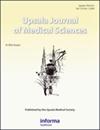溃疡性结肠炎进展:使用电子病历对疾病负担的回顾性分析
IF 1.6
4区 医学
Q2 MEDICINE, GENERAL & INTERNAL
Upsala journal of medical sciences
Pub Date : 2022-10-18
eCollection Date: 2022-01-01
DOI:10.48101/ujms.v127.8833
引用次数: 2
摘要
背景:溃疡性结肠炎(UC)是一种使人衰弱的炎症性肠病。目前关于UC疾病随时间进展的知识有限。目的:评估UC进展为严重疾病、疾病负担及相关因素。方法:使用与瑞典国家健康登记处(2005-2015)相关的电子病历来确定UC的疾病进展。比较疾病进展患者和无进展患者1年内全因住院和疾病相关住院的几率。根据病假计算年度间接费用,并检查与UC进展相关的因素。结果:在1361例中度UC患者中,24%在中位5.2年期间进展为严重疾病。与中度疾病相比,重度UC的全因发生率(OR[比值比]1.47,95% CI[置信区间]:1.12-1.94,P < 0.01)和UC相关住院率(OR 2.47, 95% CI: 1.76-3.47, P < 0.0001)显著高于中度疾病。与未进展的患者相比,进展患者的平均病假时间更长(64.4天vs 38.6天,P < 0.001),间接成本分别为151,800瑞典克朗(16,415欧元)和92,839瑞典克朗(10,039欧元)(P < 0.001)。UC的进展与年龄小(OR 1.62, 95% CI: 1.17-2.25, P < 0.01)、病程长(OR 1.09, 95% CI: 1.03-1.15, P < 0.001)和皮质类固醇的使用有关(OR 2.49, 95% CI: 1.67-3.72, P < 0.001)。结论:从中度到重度UC的疾病进展与更频繁和更长时间的住院和病假有关。年轻患者病程长,糖皮质激素用药频繁,与进展为严重UC相关。本文章由计算机程序翻译,如有差异,请以英文原文为准。



Ulcerative colitis progression: a retrospective analysis of disease burden using electronic medical records.
Background Ulcerative colitis (UC) is a debilitating inflammatory bowel disease. Present knowledge regarding UC disease progression over time is limited. Objective To assess UC progression to severe disease along with disease burden and associated factors. Methods Electronic medical records linked with Swedish national health registries (2005–2015) were used to identify disease progression of UC. Odds of all-cause and disease-related hospitalization within 1 year were compared between patients with disease progression and those without. Annual indirect costs were calculated based on sick leave, and factors related to UC progression were examined. Results Of the 1,361 patients with moderate UC, 24% progressed to severe disease during a median of 5.2 years. Severe UC had significantly higher odds for all-cause (OR [odds ratio] 1.47, 95% CI [confidence interval]: 1.12–1.94, P < 0.01) and UC-related hospitalization (OR 2.47, 95% CI: 1.76–3.47, P < 0.0001) compared to moderate disease. Average sick leave was higher in patients who progressed compared to those who did not (64.4 vs 38.6 days, P < 0.001), with higher indirect costs of 151,800 SEK (16,415 €) compared with 92,839 SEK (10,039 €) (P < 0.001), respectively. UC progression was related to young age (OR 1.62, 95% CI: 1.17–2.25, P < 0.01), long disease duration (OR 1.09, 95% CI: 1.03–1.15, P < 0.001), and use of corticosteroids (OR 2.49, 95% CI: 1.67–3.72, P < 0.001). Conclusion Disease progression from moderate to severe UC is associated with more frequent and longer hospitalizations and sick leave. Patients at young age with long disease duration and more frequent glucocorticosteroid medication are associated with progression to severe UC.
求助全文
通过发布文献求助,成功后即可免费获取论文全文。
去求助
来源期刊

Upsala journal of medical sciences
医学-医学:内科
CiteScore
5.60
自引率
0.00%
发文量
31
审稿时长
6-12 weeks
期刊介绍:
Upsala Journal of Medical Sciences is published for the Upsala Medical Society. It has been published since 1865 and is one of the oldest medical journals in Sweden.
The journal publishes clinical and experimental original works in the medical field. Although focusing on regional issues, the journal always welcomes contributions from outside Sweden.
Specially extended issues are published occasionally, dealing with special topics, congress proceedings and academic dissertations.
 求助内容:
求助内容: 应助结果提醒方式:
应助结果提醒方式:


